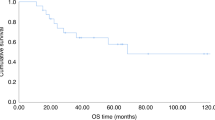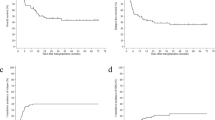Abstract
Radiation is an effective component of the transplantation conditioning regimen, for both its immunosuppressive properties and its direct antileukemia activity. Cyclophosphamide combined with total body irradiation (Cy/TBI) is the most widely used myeloablative conditioning regimen for allotransplants. We have been investigating targeted total marrow irradiation (TMI) as a more precise form of TBI delivery, in combination with cyclophosphamide, versus Cy/TBI in patients with hematologic malignancies. A prospective parallel-controlled cohort study was conducted among patients with hematologic malignancies who first underwent allogeneic peripheral blood stem cell transplantation preconditioned with TBI or TMI at our center. Eligible patients were diagnosed with acute myeloid leukemia, acute lymphoblastic leukemia, or myelodysplastic syndrome with excess blasts. Patients were assigned (1:1) to receive either TBI conditioning performed at 5Gy × 2 QD (TBI group) or TMI regimen scheduled to 4Gy × 3 QD (TMI group). Our primary objective was to determine the safety and efficacy of TMI regimen and its potential advantage of organ sparing.
Between March 2014 and June 2018, 56 eligible study participants were assigned to either the TBI group (n = 28) or the TMI group (n = 28). Patients in both arms were well balanced for gender, age, diagnosis, risk stratification, pretransplant remission status, HLA ty**, and donor source. All patients achieved successful hematopoietic reconstitution. A 1.41- to 7.45-fold reduction in median organ doses was observed with TMI compared with TBI. There was no statistical difference in overall grade II–IV acute GVHD between two arms (39.3% vs. 32.1%, p = 0.781). The cumulative incidence of chronic GVHD was higher in TBI arm (60.7% vs. 46.4%, p = 0.330). Although not statistically significant, the TMI arm showed better GVHD/relapse-free survival (GRFS) (50% vs. 32.1%, p = 0.150), decreased transplant-related mortality (TRM) (0% vs. 7.1%, p = 0.491), and better 1-year overall survival (OS) (85.7% vs. 67.9%, p = 0.352). Notably, TMI arm showed a significant lower relapse rate (3.6% vs. 32.1%, p = 0.012) and better 1-year relapse-free survival (RFS) (96.4% vs. 67.9%, p = 0.018). Of 18 female patients, 11 (61.1%) in TMI arm resumed menses at a median of 7 months (range 2–12). No menstrual recovery was observed in patients receiving TBI. Ovarian recovery rate in TMI group after transplantation was significantly higher than that in TBI group (61.1% vs. 0, p < 0.0001). TMI conditioning showed superior transplantation efficacy compared with TBI. Overall, TMI appeared to have a favorable tolerability profile compared with TBI. TMI regimen was associated with improved RFS and significant ovarian protection.
Access this chapter
Tax calculation will be finalised at checkout
Purchases are for personal use only
Similar content being viewed by others
References
Blaise D, Maraninchi D, Michallet M, et al. Long term follow-up of a randomized trial comparing the combination of cyclophosphamide with total body irradiation or busulfan as conditioning regimen for patients receiving HLA-identical marrow grafts for acute myeloblastic leukemia in first complete remission. Blood. 2001;97:3669–71.
Bunin N, Aplenc R, Kamani N, et al. Randomized trial of busulfan vs total body irradiation containing conditioning regimens for children with acute lymphoblastic leukemia: a pediatric blood and marrow transplant consortium study. Bone Marrow Transplant. 2003;32:543–8.
Latini P, Aristei C, Aversa F, et al. Lung damage following bone marrow transplantation after hyperfractionated total body irradiation. Radiother Oncol. 1991;22:127–32.
Bradley J, Reft C, Goldman S, et al. High-energy total body irradiation as preparation for bone marrow transplantation in leukemia patients: treatment technique and related complications. Int J Radiat Oncol Biol Phys. 1998;40:391–6.
Clift RA, Buckner CD, Appelbaum FR, et al. Long-term follow-up of a randomized trial of two irradiation regimens for patients receiving allogeneic marrow transplants during first remission of acute myeloid leukemia. Blood. 1998;92:1455–6.
Miller AB, Hoogstraten B, Staquet M, et al. Reporting results of cancer treatment. Cancer. 1981;47:207–14.
Kanda Y, Wada H, Yamasaki R, et al. Protection of ovarian function by two distinct methods of ovarian shielding for young female patients who receive total body irradiation. Ann Hematol. 2014;93:287–92.
Harris AC, Young R, Devine S, et al. International, multicenter standardization of acute graft-versus-host disease clinical data collection: a report from the Mount Sinai acute GVHD international consortium. Biol Blood Marrow Transplant. 2016;22:4–10.
Jagasia MH, Greinix HT, Arora M, et al. National institutes of health consensus development project on criteria for clinical trials in chronic graft-versus-host disease: I. the 2014 diagnosis and staging working group report. Biol Blood Marrow Transplant. 2015;21:389–401.
Hui S, Takahashi Y, Holtan SG, et al. Early assessment of dosimetric and biological differences of total marrow irradiation versus total body irradiation in rodents. Radiother Oncol. 2017;124:468–74.
Wong JY, Liu A, Schultheiss T, et al. Targeted total marrow irradiation using three-dimensional image-guided tomographic intensity-modulated radiation therapy: an alternative to standard total body irradiation. Biol Blood Marrow Transplant. 2006;12:306–15.
Shueng PW, Lin SC, Chong NS, et al. Total marrow irradiation with helical tomotherapy for bone marrow transplantation of multiple myeloma: first experience in Asia. Technol Cancer Res Treat. 2009;8:29–38.
Hui SK, Verneris MR, Higgins P, et al. Helical tomotherapy targeting total bone marrow - first clinical experience at the University of Minnesota. Acta Oncol. 2007;46:250–5.
Schultheiss TE, Wong J, Liu A, et al. Image guided total marrow and total lymphatic irradiation using helical tomotherapy. Int J Radiat Oncol Biol Phys. 2007;67:1259–67.
Wong JY, Rosenthal J, Liu A, Schultheiss T, et al. Image-guided total-marrow irradiation using helical tomotherapy in patients with multiple myeloma and acute leukemia undergoing hematopoietic cell transplantation. Int J Radiat Oncol Biol Phys. 2009;73:273–9.
Hui SK, Kapatoes J, Fowler J, et al. Feasibility study of helical tomotherapy for total body or total marrow irradiation. Med Phys. 2005;32:3214–24.
Rosenthal J, Wong J, Stein A, et al. Phase 1/2 trial of total marrow and lymph node irradiation to augment reduced-intensity transplantation for advanced hematologic malignancies. Blood. 2011;117:309–15.
Bath LE, Critchley HO, Chambers SE, et al. Ovarian and uterine characteristics after total body irradiation in childhood and adolescence: response to sex steroid replacement. Br J Obstet Gynaecol. 1999;106:1265–72.
Patel P, Oh AL, Koshy M, et al. A phase 1 trial of autologous stem cell transplantation conditioned with melphalan 200 mg/m2 and total marrow irradiation (TMI) in patients with relapsed/refractory multiple myeloma. Leuk Lymphoma. 2017;25:1–6.
Hui S, Brunstein C, Takahashi Y, et al. Dose escalation of total marrow irradiation in high-risk patients undergoing allogeneic hematopoietic stem cell transplantation. Biol Blood Marrow Transplant. 2017;23:1110–6.
Stein A, Palmer J, Tsai NC, et al. Phase I trial of total marrow and lymphoid irradiation transplant conditioning in patients with relapsed/refractory acute leukemia. Biol Blood Marrow Transplant. 2017;23:618–24.
Kim JH, Stein A, Tsai N, et al. Extramedullary relapse following total marrow and lymphoid irradiation in patients undergoing allogeneic hematopoietic cell transplantation. Int J Radiat Oncol Biol Phys. 2014;89:75–81.
Jadoul P, Donnez J. How does bone marrow transplantation affect ovarian function and fertility? Curr Opin Obstet Gynecol. 2012;24:164–71.
Chiodi S, Spinelli S, Bruzzi P, et al. Menstrual patterns, fertility and main pregnancy outcomes after allogeneic haematopoietic stem cell transplantation. J Obstet Gynaecol. 2016;36:783–8.
Nakano H, Ashizawa M, Akahoshi Y, et al. Assessment of the ovarian reserve with anti-Müllerian hormone in women who underwent allogeneic hematopoietic stem cell transplantation using reduced-intensity conditioning regimens or myeloablative regimens with ovarian shielding. Int J Hematol. 2016;104:110–6.
Socié G, Salooja N, Cohen A, et al. Nonmalignant late effects after allogeneic stem cell transplantation. Blood. 2003;101:3373–85.
Pesty A, Doussau M, Lahaye JB, et al. Whole-body or isolated ovary (60) co irradiation: effects on in vivo and in vitro folliculogenesis and oocyte maturation. Reprod Toxicol. 2010;29:93–8.
Adriaens I, Smitz J, Jacquet P. The current knowledge on radiosensitivity of ovarian follicle development stages. Hum Reprod Update. 2009;15:359–77.
Levine J, Canada A, Stern CJ. Fertility preservation in adolescents and young adults with cancer. J Clin Oncol. 2010;28:4831–41.
Loren AW, Mangu PB, Beck LN, et al. Fertility preservation for patients with cancer: American society of clinical oncology clinical practice guideline update. J Clin Oncol. 2013;31:2500–10.
Lie Fong S, Lugtenburg PJ, Schipper I, et al. Anti-müllerian hormone as a marker of ovarian function in women after chemotherapy and radiotherapy for haematological malignancies. Hum Reprod. 2008;23:674–8.
Fraisse T, Ibecheole V, Streuli I, et al. Undetectable serum anti-müllerian hormone levels and occurrence of ongoing pregnancy. Fertil Steril. 2008;89:723.e9–11.
Singhal S, Powles R, Treleaven J, et al. Melphalan alone prior to allogeneic bone marrow transplantation from HLA-identical sibling donors for hematologic malignancies: alloengraftment with potential preservation of fertility in women. Bone Marrow Transplant. 1996;18:1049–55.
Byrne J, et al. Early menopause in long-term survivors of cancer during adolescence. Am J Obstet Gynecol. 1992;166:788–93.
Meirow D, Nugent D. The effects of radiotherapy and chemotherapy on female reproduction. Hum Reprod Update. 2001;7:535–43.
Lopez-Ibor B, Schwartz AD. Gonadal failure following busulfan therapy in an adolescent girl. Am J Pediatr Hematol Oncol. 1986;8:85–7.
Steffens M, Beauloye V, Brichard B, et al. Endocrine and metabolic disorders in young adult survivors of childhood acute lymphoblastic leukaemia (ALL) or non-Hodgkin lymphoma (NHL). Clin Endocrinol. 2008;69:819–27.
Hovi L, Saarinen-Pihkala UM, Taskinen M, et al. Subnormal androgen levels in young female bone marrow transplant recipients with ovarian dysfunction, chronic GVHD and receiving glucocorticoid therapy. Bone Marrow Transplant. 2004;33:503–8.
Sanders JE, Buckner CD, Amos D, et al. Ovarian function following marrow transplantation for aplastic anemia or leukemia. J Clin Oncol. 1988;6:813–8.
Author information
Authors and Affiliations
Editor information
Editors and Affiliations
Rights and permissions
Copyright information
© 2020 Springer Nature Switzerland AG
About this chapter
Cite this chapter
Lou, X., **a, TY., Chen, H. (2020). Improved Clinical Outcome After Total Marrow Irradiation Conditioning Stem Cell Transplantation for Hematologic Malignancies. In: Wong, J., Hui, S. (eds) Total Marrow Irradiation. Springer, Cham. https://doi.org/10.1007/978-3-030-38692-4_12
Download citation
DOI: https://doi.org/10.1007/978-3-030-38692-4_12
Published:
Publisher Name: Springer, Cham
Print ISBN: 978-3-030-38691-7
Online ISBN: 978-3-030-38692-4
eBook Packages: MedicineMedicine (R0)




